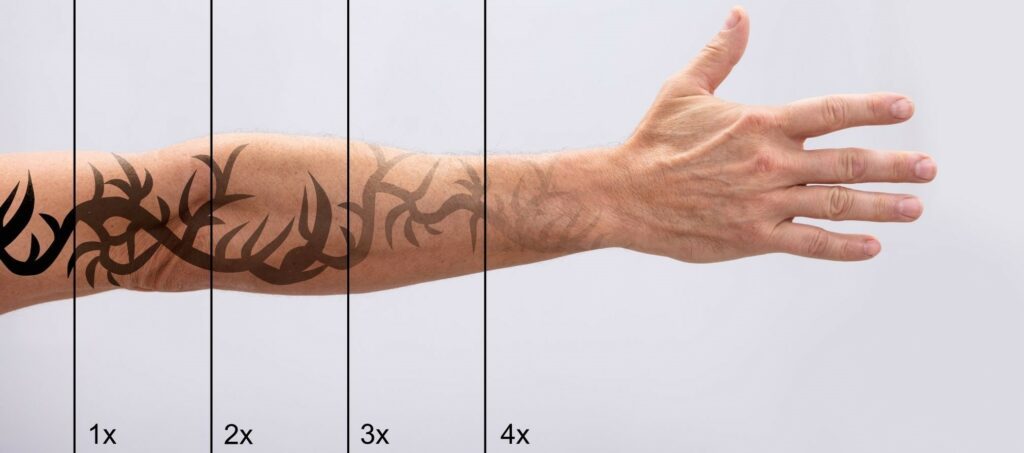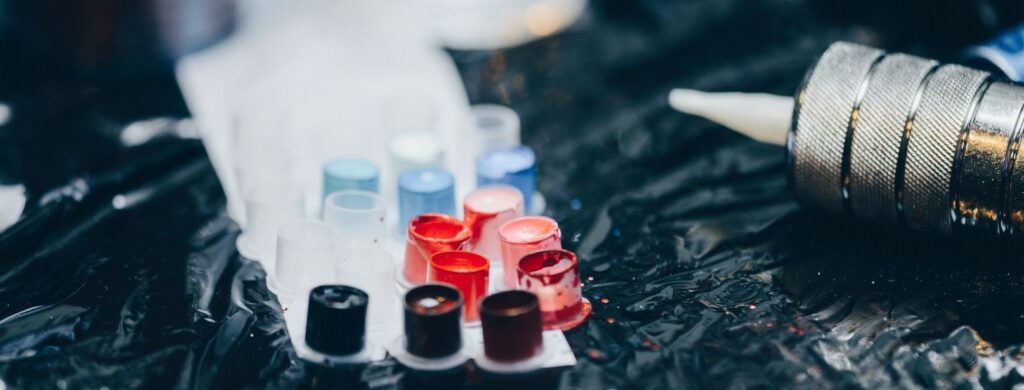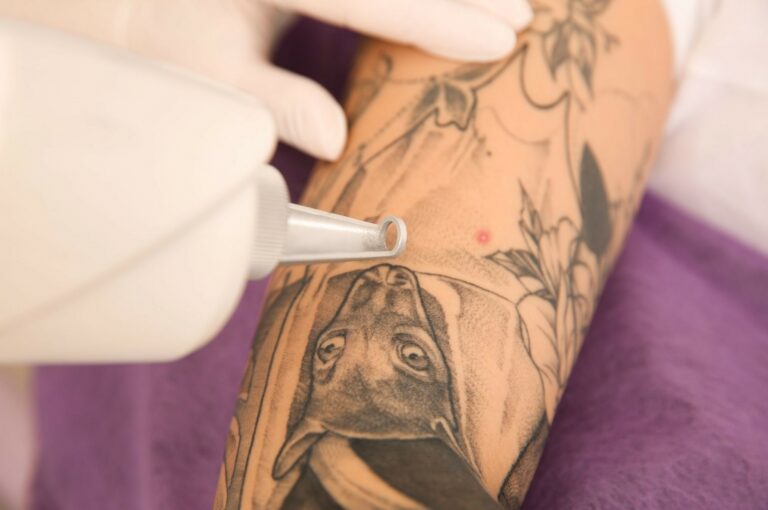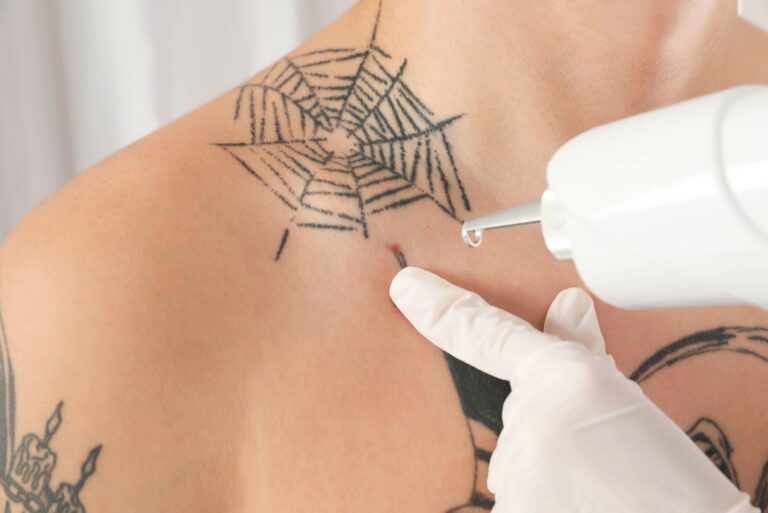Tattoo Lightening Methods and Their Outcomes
Introduction
Tattoos are a popular form of self-expression for many people. They can represent significant events, people, or things in our lives and serve as a permanent reminder of these memories.
However, sometimes we may want to remove or lighten a tattoo due to various reasons such as regret, change in beliefs, or simply because the design is no longer appealing to us. Tattoo lightening is the process of removing or reducing the appearance of a tattoo by breaking up the ink particles beneath the skin’s surface.
This process can be done through various methods such as traditional methods like dermabrasion and chemical peels or more modern approaches like laser tattoo removal. The outcome of each method varies depending on several factors such as the size, color, age of the tattoo, and individual factors such as skin type.

Overview of Different Methods for Tattoo Lightening
There are different methods available for tattoo lightening that offer varying degrees of effectiveness, safety, and cost. Some traditional techniques include dermabrasion and chemical peels while modern approaches include laser tattoo removal. There are also natural remedies that can help lighten tattoos such as lemon juice, aloe vera gel, and honey.
Dermabrasion involves using an abrasive tool to scrape off layers of skin where ink pigments reside. Chemical peels use acids to dissolve the top layers of skin where ink pigments are deposited.
Both methods aim to fade tattoos over time but may cause scarring or discoloration when not done correctly. Laser tattoo removal uses high-intensity laser beams that break down ink particles into smaller fragments which can be removed by the body’s immune system over time naturally.
This approach is considered safer than traditional methods since it doesn’t damage surrounding tissue but may require multiple sessions for complete removal. Natural remedies like lemon juice, aloe vera gel, and honey are thought to help lighten tattoos by breaking down ink particles.
However, their effectiveness may vary depending on the tattoo’s size and color and may not be as effective as other methods. Overall, the choice of tattoo lightening method depends on various factors such as the type of tattoo you have, your skin type, budget, and desired outcome.
It is essential to weigh the pros and cons of each method carefully before making a decision. In this article, we will explore different tattoo lightening methods in detail to help you make an informed decision about which approach suits your needs best.
Traditional Methods for Tattoo Lightening
Tattoos have been a symbol of self-expression for centuries, but what if you no longer want your once-cherished tattoo? Traditional methods of tattoo removal may be the solution. Two popular traditional methods for tattoo lightening are dermabrasion and chemical peels.
Explanation of Dermabrasion and Its Effectiveness in Removing Tattoos
Dermabrasion is a technique performed by a dermatologist or plastic surgeon using a high-speed rotary device to sand down the skin. This method has been used since the 1950s to remove tattoos, scars, and wrinkles.

During the procedure, local anesthesia is administered, and tiny particles are directed at the skin surface. These particles abrade the top layer of skin and assist in removing the ink pigments.
The effectiveness of dermabrasion depends on various factors such as age, skin type, location of the tattoo on your body, depth of ink penetration into your skin, size of the tattoo, and color intensity. Dermabrasion can lighten tattoos by up to 50%, but multiple treatments are often required to see results.
Discussion of Chemical Peels and How They Work to Lighten Tattoos
A chemical peel involves the application of an acidic solution onto the surface layers of the skin housing the tattoo. This process intentionally inflicts controlled chemical damage, aiming to remove or lighten the layers containing pigmented cells and make the tattoo less noticeable.
While chemical peels claim to address tattoos of all types and colors, their effectiveness is more pronounced on smaller tattoos with lighter ink pigments like green or blue. The composition of these lighter pigments makes them more responsive to the chemical peel’s action, resulting in a higher likelihood of fading.
The number of treatments necessary for satisfactory tattoo lightening can vary significantly among individuals. Factors such as age, skin type, color intensity, size, and location of the tattoo contribute to the treatment duration and outcomes. These variables collectively determine the potential effectiveness and speed of the tattoo fading process.
However, it is important to note that chemical peels may fall short of guaranteeing complete tattoo removal or achieving the desired level of fading. Results can vary considerably depending on individual circumstances. It is advisable to consult with a qualified professional to assess the suitability of chemical peels for a particular tattoo and manage expectations accordingly.
Pros and Cons of Traditional Methods
Traditional methods of tattoo removal may seem like an attractive option for those looking to get rid of their ink, but it’s not always the best approach. Dermabrasion and chemical peels come with their own set of pros and cons. Pros: These methods are cheaper than laser tattoo removal, they can be performed quickly and may be preferred by some people who don’t want to undergo multiple laser treatments.
Cons: They both can be painful procedures that require time off work while your skin heals. Dermabrasion can leave scars or cause skin discoloration if not done correctly.
Chemical peels can also result in pigmentation changes and scarring. If you are considering traditional methods for tattoo lightening, it’s essential to understand the potential side effects and ensure you choose a qualified professional to perform the procedure.
Laser Tattoo Removal
Explanation of Laser Tattoo Removal Process
Laser tattoo removal is a common method used by dermatologists and tattoo removal specialists to get rid of unwanted tattoos. The process involves using high-intensity light beams to break down the ink particles in the skin. The laser emits pulses of light that selectively target pigment molecules within the skin.
As a result, the ink particles absorb the laser energy and break it down into smaller fragments that can be eliminated by the body’s lymphatic system. During the procedure, the specialist will apply numbing cream or local anesthesia to minimize discomfort.
The laser device is then placed directly on top of the tattooed area, emitting short bursts of energy that shatter ink particles into tiny fragments. The procedure can take several sessions depending on factors such as tattoo size, ink color, and depth.
Different Types of Lasers Used in the Process
There are several types of lasers used for tattoo removal procedures including Q-switched lasers, PicoSure lasers, Picoway lasers, and more recently Discovery Pico lasers. Q-switched (Quality-Switched) lasers are currently considered one of the most effective options for removing tattoos due to their ability to emit high-intensity pulses at nanosecond intervals. These lasers are designed to target specific colors or wavelengths associated with different pigments within tattoos.
PicoSure and Picoway lasers are newer technologies in laser tattoo removal which employ ultra-short pulse durations (picoseconds) compared with nanosecond duration in Q-switched lasers. These ultra-short pulse durations have shown promising results in removing green and blue pigments.
Discovery Pico is another new generation picosecond technology platform like Picoway & Picosure which uses two wavelengths (532 nm / 1064 nm ) on very short pulse duration (<400 picoseconds). It covers most of the colors with high safety and efficacy profiles.
Factors that Affect the Outcome of Laser Tattoo Removal
Several factors can affect the outcome of laser tattoo removal, including tattoo location, age, depth, ink color, and skin type. Tattoos located on areas with poor blood circulation such as hands and feet may be harder to remove compared to those located on areas with better blood flow. Tattoos that are older may also take longer to remove because the ink molecules have had more time to settle within deeper layers of skin.
Ink color is another important factor in determining the effectiveness of laser tattoo removal. Darker colors like black and blue are usually easier to remove compared to lighter colors like yellow and green.
Skin type also plays a role as those with darker skin tones may have a higher risk of developing scarring or discoloration after laser treatment due to higher levels of melanin in their skin. Laser tattoo removal remains one of the most effective options for removing unwanted tattoos.
However, it is important to consider various factors that can affect its success rate. Patients should always consult with a qualified dermatologist or tattoo removal specialist before undergoing any kind of treatment.
Natural Methods for Tattoo Lightening Tattoo lightening methods that use natural ingredients have been gaining popularity in recent years.
One of the most common natural methods is using lemon juice to lighten tattoos. Lemon contains natural bleaching agents that can help fade the pigments of a tattoo over time.
To use this method, you need to cut a lemon in half and squeeze its juice onto a cotton ball or swab. Then, rub the tattooed area gently with the cotton ball for about 10-15 minutes before rinsing it off with warm water.
Repeat this process twice a day until you notice any significant changes. Another popular natural method is using aloe vera gel to lighten tattoos.
Aloe vera has anti-inflammatory and skin-soothing properties that can help speed up skin healing and reduce inflammation caused by tattoo pigments. To use this method, apply a generous amount of fresh aloe vera gel directly onto the tattooed area and massage it in gently for about 10-15 minutes before rinsing it off with warm water.
Repeat this process twice daily until you achieve your desired results. Honey is yet another natural ingredient that can be used to lighten tattoos naturally.
Honey contains enzymes that can break down the ink particles of a tattoo and gradually remove them from your skin over time. To use this method, mix equal parts honey and Aloe Vera gel together before applying to your tattooed area for around 30 minutes and wiping away with warm water.
While these natural methods for lightening tattoos sound appealing due to their non-invasive nature, they do come with certain limitations and potential side effects as well. One major limitation is that these methods may not work as quickly or effectively as other lightening techniques such as laser removal or dermabrasion especially when dealing with larger or more intricate tattoos which require more drastic measures.
Additionally, results may vary depending on factors such as skin type, age of the tattoo, depth of the ink, and the quality of the ingredients used. Potential side effects of natural lightening methods can include skin irritation, allergic reactions, and discoloration.
It is important to be aware of these risks before attempting any natural lightening methods. If you experience any adverse effects, discontinue use immediately and speak with a dermatologist about other options for lightening your tattoo.
Tattoo Cover-Ups
Cover-up tattoos are an excellent solution for those who wish to hide or replace their old tattoos. Cover-up tattoos involve strategically placing a new tattoo design over an existing one, effectively hiding the original tattoo. The process of covering up a tattoo requires skill and expertise to ensure that the end result is seamless and appears natural.
Explanation of how cover-up tattoos can be used to hide or replace old tattoos
Covering up a tattoo involves several stages, including consultations with experienced tattoo artists. The consultation stage is crucial since the artist needs to understand what kind of design will adequately cover the existing tattoo and blend in with the skin tone of the individual. Additionally, when hiding an old tattoo, it is essential to select designs that incorporate more shading and darker colors so that they can cover up any ink that may be visible through the new design.
The process of covering up a tattoo usually requires multiple sessions since it may be necessary first to lighten the existing ink using laser removal techniques before applying another design over it. The type of design selected will also determine how many sessions are required since intricate designs may require more time than simpler ones.
Different styles and techniques used in cover-up tattoos
There are different styles and techniques that artists use when creating cover-up tattoos. Some popular styles include traditional American-style tattoos, Japanese-style, tribal designs, and blackwork.
- American-Style Tattoos: This style features bold lines, bright colors, and intricate detailing with heavy shading. It’s often used for colorful designs that involve flowers or animals.
- Japanese-Style: This style comprises lots of detail through symbols such as dragons or cherry blossoms. It typically features a lot of black ink with accents of bright red or blue colors.
- Tribal Designs: This style incorporates symbols from various cultures for a unique design. It may feature dark, thick lines and solid black shapes.
- Blackwork: This style features plain black ink, often with intricate geometric shapes or designs. It’s a great option for those who want a more subtle cover-up that doesn’t draw too much attention to the tattoo.
In terms of techniques, some artists prefer to use blending techniques such as incorporating the existing tattoo into the new design. Alternatively, they may use color contrast and shading to create an entirely new image over the old tattoo. Regardless of the technique used, it’s essential to find an artist with experience in cover-up tattoos to ensure that you get the best possible outcome for your specific needs.
Covering up an old tattoo is an excellent solution for those who wish to hide or replace their current tattoos. The process requires skill and expertise from both the artist and the individual getting the cover-up tattoo.
Some popular styles include American-style tattoos, Japanese-style, tribal designs, and blackwork. Understanding these different styles can help you select an artist who can deliver your desired results effectively.
Risks Associated with Tattoo Lightening Methods
Scarring
One of the most significant risks associated with tattoo lightening methods is scarring. Dermabrasion and chemical peels, for instance, remove the top layers of skin to reach the tattoo ink. While this process can effectively lighten tattoos, it may also lead to scarring.
The degree of scarring depends on several factors such as the size and location of the tattoo, individual skin type, and healing abilities. Some scars may fade over time while others may be permanent and require further treatment.
Laser tattoo removal may also cause scarring if not done correctly. Laser beams used in tattoo removal penetrate the skin deeply enough to break down the ink particles but can inadvertently damage surrounding tissues leading to raised or sunken scars which is why choosing an experienced laser technician is essential.
Infection
Infection is another potential complication associated with tattoo lightening methods. When undergoing dermabrasion or chemical peels, you risk infection if proper hygiene procedures are not followed before, during, and after treatment.
The same applies to laser treatment; since it involves breaking down skin tissues and exposing them to external factors that could cause infection. To mitigate these risks, all equipment should be sterile before use; patients should avoid touching treated areas except as directed by their medical practitioner or technician; patients should also keep treated areas clean by following proper post-care instructions provided by their practitioner.
Skin Discoloration
Skin discoloration is another risk associated with certain tattoo lightening methods. For instance, using natural ingredients like lemon juice could lead to hyperpigmentation (darkened patches) or hypopigmentation (lightened patches) depending on your skin type’s reaction to citrus fruit acidity.
In some instances, laser treatments have been known to cause uneven pigmentation because some colors in tattoos may not respond well to certain laser wavelengths used in tattoo removal. This means that the surrounding skin may become darker or lighter than it originally was, creating an uneven skin tone.
Delayed Healing
Some tattoo lightening methods can cause delayed healing. For instance, dermabrasion and chemical peels remove the top layers of skin and expose the lower layers to external factors like sun exposure which can slow down the healing process.
If these treatments are not done correctly or if proper post-care instructions are not followed, it could result in longer healing times and increased discomfort. Tattoo lightening has its risks like any other medical procedure.
However, by choosing an experienced medical practitioner or technician for your treatment and following proper post-care instructions diligently will help mitigate these risks. Remember that scarring, infection, skin discoloration, and delayed healing are potential complications of tattoo-lightening methods; therefore it is essential to weigh the benefits against the risks before deciding on a particular method.
Key Takeaways
There are various tattoo lightening options available to those who seek to remove or fade their tattoos. Traditional methods such as dermabrasion and chemical peels have been around for decades and can be effective in some cases. However, these methods also carry a higher risk of scarring and skin discoloration compared to newer laser technologies.
Laser tattoo removal is the most popular method of tattoo lightening today due to its effectiveness and reliability. It may require multiple sessions depending on factors such as the size, color, location, and age of the tattoo.
Different types of lasers can be used for different ink colors or skin tones. Laser tattoo removal is generally safe when performed by a trained professional, but it still carries some risks such as blistering, infection, or hypo/hyperpigmentation.
Natural remedies such as lemon juice, aloe vera gel, or honey have been promoted as alternative methods for fading tattoos without using harsh chemicals or lasers. While they may have some mild exfoliating effects that can help reduce pigmentation over time, they are unlikely to completely remove tattoos on their own.
In addition, these remedies may cause allergic reactions or irritation in some people’s skin. Cover-up tattoos can be a creative solution for individuals who want to hide their old tattoos with new designs instead of removing them completely.
A skilled artist can incorporate elements from the old tattoo into the new one to make it look seamless and cohesive. However, cover-up tattoos require more planning and commitment than other methods since they involve getting a brand-new tattoo on top of an existing one.
Overall, the best method for tattoo lightening depends on several factors including personal preference, budget constraints, skin type/sensitivity/health condition/history, etc. It’s important to research your options carefully before making any decisions regarding your body art. Consult with reputable professionals in person or online if you need guidance on what will work best for you.
Remember, there’s no shame in changing your mind about your tattoos over time. Life is a journey, and our bodies are our canvases.
References
Is Tattoo Removal Safe? 5 Methods Reviewed https://londonpremierlaser.co.uk/blog/is-tattoo-removal-safe/
Tattoo Removal: Techniques and Devices | SpringerLink
Medical Disclaimer:
The information provided on this website regarding tattoo removal techniques is for general informational purposes only. It is not intended to be a substitute for professional medical advice, diagnosis, or treatment. Always seek the advice of a qualified healthcare professional regarding any medical condition or concerns, including tattoo removal.
The content presented on this website should not be interpreted as endorsing or promoting any specific tattoo removal technique, product, or service. The effectiveness, safety, and suitability of tattoo removal methods can vary depending on individual circumstances and factors. Therefore, it is crucial to consult with a medical professional or qualified specialist before making any decisions or embarking on any tattoo removal procedure.
The website does not guarantee the accuracy, completeness, or reliability of the information provided. Reliance on any information from this website is solely at your own risk. The website and its owners, authors, and contributors shall not be held liable for any damages or consequences arising from the use of the information provided.
It is important to note that medical practices and standards may change over time, and the information provided on this website may not always reflect the most up-to-date research or guidelines. Therefore, it is recommended to consult with healthcare professionals or reputable sources for the latest information and advice on tattoo removal techniques.
If you experience any adverse reactions, complications, or concerns during or after a tattoo removal procedure, promptly seek medical attention. Only a qualified healthcare professional can assess your specific situation and provide appropriate advice and treatment.
By using this website, you acknowledge and agree to the above disclaimer, and you understand that the website and its owners, authors, and contributors cannot be held responsible for any decisions or actions taken based on the information provided.






